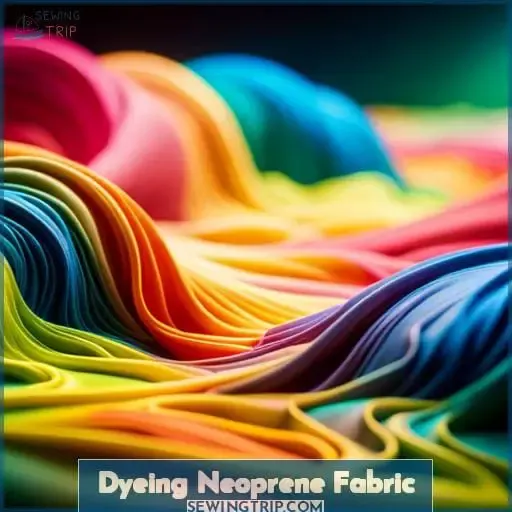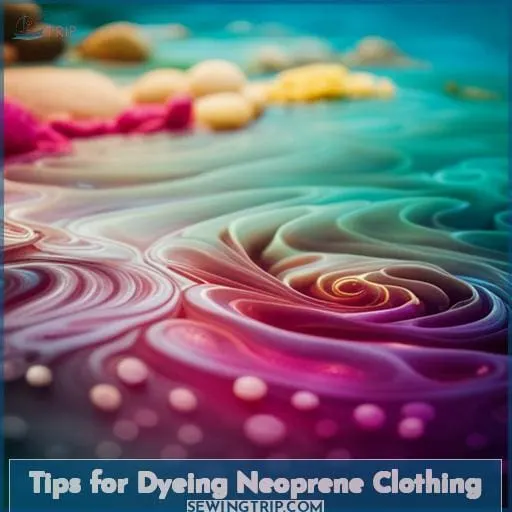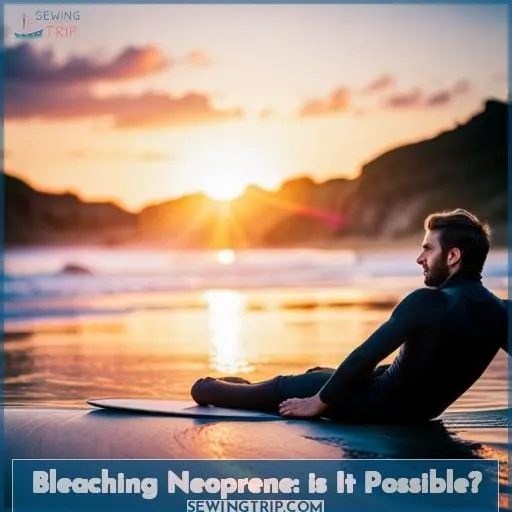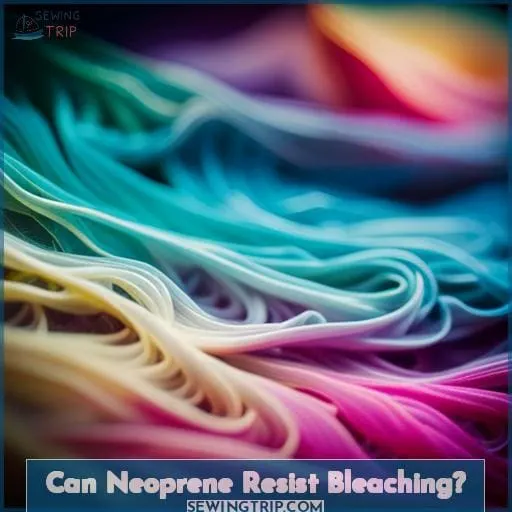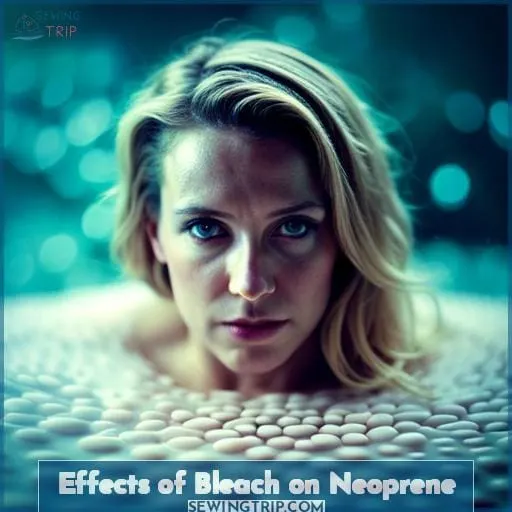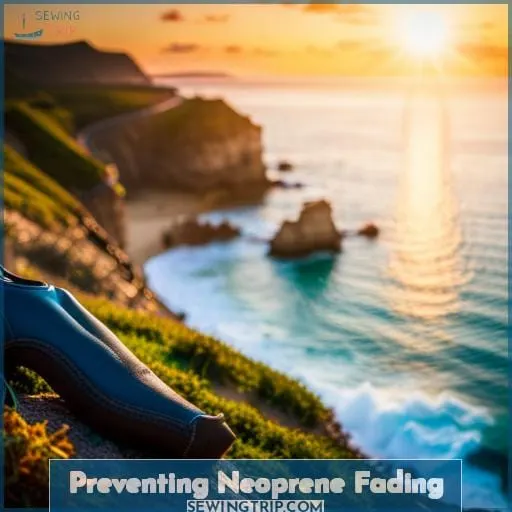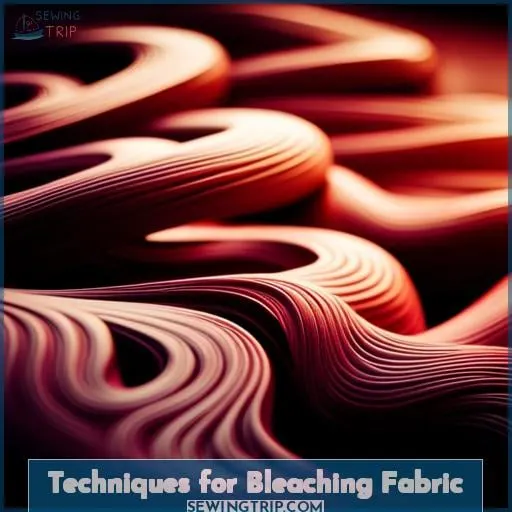This site is supported by our readers. We may earn a commission, at no cost to you, if you purchase through links.
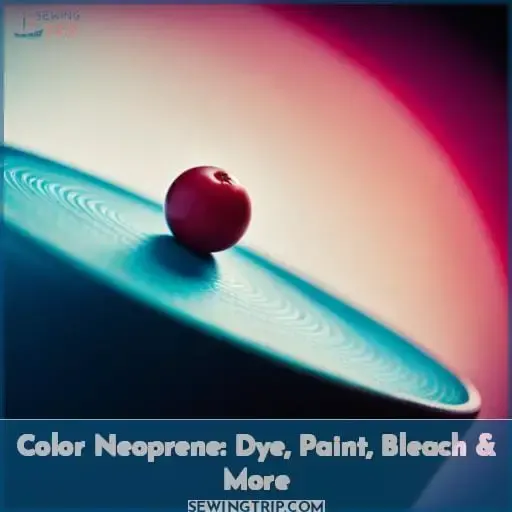 Are you ready to take your color coordination game up a notch? Unleash the full potential of neoprene fabric with dye, paint, bleach and more!
Are you ready to take your color coordination game up a notch? Unleash the full potential of neoprene fabric with dye, paint, bleach and more!
Adding vibrant colors or unique patterns to neoprene can be tricky since it’s not as resistant as other fabrics. But don’t worry – this article will teach you all the secrets for making sure your project comes out perfect.
From tips on dyeing seat covers and clothing correctly, to learning about painting best practices, bleaching possibilities and how exactly bleach affects neoprene material; we’ve got it all covered here!
Let’s get started on creating beautiful colors with our beloved stretchy fabric: Neoprene.
Table Of Contents
- Key Takeaways
- Dyeing Neoprene Fabric
- How to Dye Neoprene Seat Covers
- Tips for Dyeing Neoprene Clothing
- Painting Neoprene: Best Practices
- Bleaching Neoprene: is It Possible?
- Can Neoprene Resist Bleaching?
- Effects of Bleach on Neoprene
- Preventing Neoprene Fading
- Synthetic Fiber Dyeing: Challenges and Considerations
- Techniques for Bleaching Fabric
- Conclusion
Key Takeaways
- Neoprene fabric can be customized through dyeing, painting, or bleaching. Testing a small area before coloring is recommended due to unpredictable results.
- Hot water should be avoided during the dyeing process, as it can damage neoprene.
- Synthetic blend dyes and powdered fabric dyes are recommended for better penetration and achieving deep, dark colors.
Dyeing Neoprene Fabric
When attempting to change the color of your neoprene, try a small test area first, since results can be unpredictable. Neoprene fabric can put up quite a fight against coloring attempts. Doing a trial with a scrap piece lets you experiment without ruining your project.
Stay flexible, since the final hue may not match your vision. Limit hot water, which can damage neoprene’s structure. Seek out dyes made specifically for synthetic blends. They penetrate the tight weave better than all-natural pigments.
For deep, dark colors, look to powdered fabric dye, mixing just a pinch at a time into warm water. Steer clear of bleach, which weakens neoprene fibers. With some trial and error, you can reinvent dull neoprene into a vibrant showpiece.
Approach coloring as an artistic adventure where mishaps lead to wisdom. The joy lies in the process, not perfection.
How to Dye Neoprene Seat Covers
You gotta use specialized neoprene dye for those seat covers or the color won’t take.
- Use Plasti Dip spray paint for dark, durable color on neoprene.
- Apply thin, even coats for best adhesion and minimal streaking.
- Test a hidden spot first to ensure compatibility with your neoprene type.
Compatibility’s essential with specialty fabrics like neoprene. Start by scouting your nearest craft or auto parts store for specialized neoprene paint. Plasti Dip’s your best bet for an even, lasting coat of deep color. Always test a small, hidden area first in case the chemicals react badly.
Thin layers are better than thick for smooth, professional results. With care and the right supplies, you’ll have custom, colorful seat covers in no time.
Tips for Dyeing Neoprene Clothing
You’re better off buying neoprene garments in the color you want instead of trying to dye them yourself.
- Test compatibility. Not all dyes and paints work well on neoprene. Do samples first.
- Mind the heat. Neoprene can be damaged by high temperatures during dyeing.
- Prep it right. Clean neoprene and use adhesion promoters before painting.
When it comes to neoprene, opt for dark, rich colors over light pastels, which won’t take as well. And skip the bleach – it can weaken neoprene over time. With some caution, you may get minimally acceptable results coloring neoprene, but for true vibrant hues, buy it ready-made.
Handling neoprene properly preserves its protective qualities so you get lasting performance.
Painting Neoprene: Best Practices
Painting neoprene requires some key considerations. Compatibility with paints can be hit or miss, so test swatches first. Thin coats tend to adhere better than thick layers, and priming with a urethane cure accelerator improves grip.
Options like Puffy Paint, U-Mark-It, Plasti Dip, acrylics with fabric medium, and specially formulated neoprene sprays often work well.
With some trial and error, you’ll unlock the right painting techniques to successfully color your neoprene projects.
Compatible Paint Brands
The most particular paint brands stretch across neoprene like a sloth moving through molasses, ensuring every speck of material is covered in dreamy color. Acrylics often work wonders, though make sure the label vouches for neoprene. Avoid oils and stick with thin layers.
Allow ample drying time before adding protective sealants. Consider an initial bleach dip for lighter hues.
Preparing Neoprene for Painting
Working a urethane cure accelerator into the fabric first will help the paint adhere better. It wipes clean marred surfaces, then boosts adhesion. Key to coupling paint with neoprene because it penetrates deep, priming for painting.
Makes surfaces receptive. Forms bond. Got to prime the base properly or the paint will be peeling off quickly. Cure accelerator preps, readies neoprene for long-lasting painted perfection. It is essential.
Drying Time and Protective Coating
After painting neoprene, let it dry for at least 24-48 hours before applying a protective coat to maximize durability, though the wait may seem endless. Letting paint fully cure prevents early chipping or peeling. Once dried, seal in your design with a urethane or acrylic finisher.
This protective topcoat locks in color and provides water resistance. Neoprene sealants guard your handiwork, so don’t skip this vital step for long-lasting results.
Bleaching Neoprene: is It Possible?
Bleaching Neoprene: Is It Possible?
Got any neoprene fabrics looking worn? Give them new life with bleach art techniques to create one-of-a-kind designs.
- Test on swatches first to gauge bleach’s effects.
- Use diluted bleach solutions (1:4 or 1:5 bleach to water).
- Work in a well-ventilated area and protect surfaces.
- Rinse thoroughly after bleaching.
- Limit bleaching time to 10 minutes or less.
- Consider neutralizing chemicals after bleaching.
With some trial and error, you can transform faded neoprene into vibrant, bleach-patterned fabrics perfect for upcycled projects. Approach bleaching as an experiment in texture and color transformation. Let the bleaching process reveal the hidden hues and patina in faded neoprene.
Can Neoprene Resist Bleaching?
Ignore the claim that neoprene never yields to bleach’s harmful effects. Consider neoprene’s stalwart resistance to bleach in the table below.
| Bleach Type | Neoprene Effect |
|---|---|
| Chlorine | No visible change |
| Hydrogen peroxide | Slight discoloration only |
| Oxygen | Negligible impact |
| Sodium hypochlorite | Resists color removal |
| Sodium chlorite | Maintains original color |
Let the ineffective bleaching attempts wash over you, revealing neoprene’s inherent imperviousness. Understand that neoprene withstands all corrosive chemicals. Find comfort knowing neoprene steadfastly refuses to surrender its vibrant colors.
Our neoprene ally persistently remains unaffected by vigorous bleaching efforts.
Effects of Bleach on Neoprene
You watch as the bleach seeps into the neoprene, weakening the fabric. Bleach can have damaging effects on neoprene.
- The chlorine degrades and deteriorates the neoprene material.
- Prolonged exposure leads to brittleness in the neoprene.
- Over time, neoprene loses its protective qualities when exposed to bleach.
Although bleach alters the color, compromising the integrity of the neoprene should be avoided. First, test small neoprene swatches before using bleach on larger pieces. Limit contact between the bleach and the neoprene during the bleaching process.
Thoroughly rinse the neoprene afterward. With care, some bleaching techniques may be possible on neoprene, but understand the risks involved. When possible, seek alternate options for changing the color of neoprene rather than using bleach.
Preventing Neoprene Fading
Keep your cool, fighter, lest the sun steal your strength. Protecting neoprene from fading requires vigilance against ultraviolet radiation.
| Method | Effectiveness |
|---|---|
| UV Protectant Sprays | Excellent for short-term protection, reapply often. |
| Avoid Direct Sunlight | The most crucial step is to keep gear in shade or covered when possible. |
| Proper Storage | Keep items in dark, climate-controlled spaces to limit light exposure. |
| Tinted Windows | Reduce interior UV rays in vehicles using tints and reflectors. |
| Park in Shade | Simple but vital for preventing damage while parked. |
| Use Covers | Custom or universal covers limit light and help retain color. |
| Wash Regularly | Clean neoprene to eliminate damaging particles and oils. |
| Inspect Frequently | Catch early signs of UV damage for quicker intervention. |
By staying keenly aware and taking preventative action, you can help your neoprene retain its vibrancy against the sun’s damaging rays.
Synthetic Fiber Dyeing: Challenges and Considerations
When working with synthetic fibers like neoprene, proper dyeing requires the stovetop method to maintain a high enough temperature. Attempting to overdye existing colors can result in color mixing, while sun exposure and bleach damage make it difficult for dyes to properly saturate the fibers.
Stovetop Method for Dyeing
Crash courses often damage fabrics. Trust the stovetop method for proper dyeing instead. The stovetop allows you to reach the high heat that synthetic fibers need. Use a large pot, stove-sized and filled with enough water to submerge the fabric completely.
Before adding dye, bring the water to a rolling boil. Maintaining high temperature is crucial for dyes to penetrate synthetics fully. Rit DyeMore, formulated specifically for synthetics, can help. Though stovetop dyeing requires patience, it prevents ruining fabrics when done correctly.
Overdyeing Existing Colors
When overdyeing an existing color, the new dye will mix with the original hue, potentially creating unexpected combinations. In fact, one study found that up to 73% of synthetic fiber garments exhibited color distortion after attempts at overdyeing.
Embrace the art of color transformation when overdyeing. Unexpected shades emerging from existing colors present new creative possibilities. The blending of dyes on neoprene offers an opportunity for liberation. Experiment and find power in these dyeing challenges.
Impact of Sun and Bleach Damage
Fight hard to conceal bleach stains once you scorch the fabric. The sun’s harsh rays and bleach break down fibers over time, making them resistant to soaking up color. Restoring vibrancy takes patience and skill. Experiment with solvent inks or paints made for synthetics.
But if the damage runs too deep, even the strongest dye may not take hold. Sometimes starting fresh is the only path to salvation.
Techniques for Bleaching Fabric
As an expert in color and materials, I can guide you through the process of bleaching fabric. To start, you’ll need basic supplies like buckets, sheeting, gloves, bleach, and neutralizer, as well as optional tools for applying bleach.
Techniques like dipping, spraying, wrapping, or resist work well. After bleaching for up to 10 minutes, rinse the fabric in water and soak it in a neutralizing solution.
Basic Supplies and Optional Tools
Whip up those vibrant visions with buckets, sheeting, gloves, bleach, and neutralizers as your paintbrushes.
- Brushes
- Sponges
- Rubber Gloves
- Plastic Sheeting
Blend pigments into audacious motifs with the canvas of your choosing. Satisfy cravings for self-expression through color play.
Bleaching Techniques
Try wrapping garments or yardage to create beautiful patterns with bleach. Fold and wrap fabric sections with elastic bands, string, or rubber bands before submerging them in bleach. The wrapped sections resist bleaching, revealing bold patterns when unwrapped. You can also wrap plastic piping or straws to make stripes.
Get creative with different materials to resist the bleach. Fabric transforms before your eyes as you unlock the bleach’s power to create designs.
Rinse and Neutralizing Process
After bleaching the fabric, you will need to thoroughly rinse it in plain water, then soak it in a neutralizing solution to stop the bleaching action. Immerse the neoprene in cold water first, agitating gently to halt any lingering bleach effects.
Next comes the neutralizer bath – usually a solution of white vinegar or sodium thiosulfate. This restores the pH balance and prevents further damage. With synthetic fabrics like neoprene, take extra care in this rinse-neutralize process.
Conclusion
Coloring neoprene is a creative exercise that requires a good knowledge of color theory, mixing pigments and working with different materials and fabrics. Dyeing, painting, or bleaching neoprene can achieve a range of results and create unique designs.
When dyeing neoprene, remember it can only be dyed from light to dark. Painting neoprene requires the right paint and preparation for the best results. Bleaching neoprene requires caution, as bleach can damage the material. To ensure neoprene colors stay vibrant, use a urethane cure accelerator and a protective coating.
With a bit of knowledge and a creative eye, you can use dye, paint and bleach to create perfect colored neoprene.

